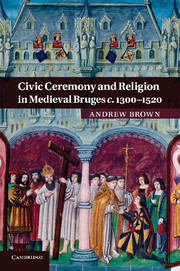Book contents
- Frontmatter
- Contents
- List of figures
- List of maps
- Acknowledgments
- List of abbreviations
- Note on currency and monies of account
- Introduction
- 1 The Holy Blood procession
- 2 General processions
- 3 Feast days and liturgical commemoration
- 4 Guilds: feast, festivity and public worship
- 5 Guilds and civic government
- 6 Civic charity
- 7 Civic ceremony, religion and the counts of Flanders
- Conclusion and epilogue: civic morality c. 1500
- Appendices
- Bibliography
- Index
1 - The Holy Blood procession
Published online by Cambridge University Press: 03 May 2011
- Frontmatter
- Contents
- List of figures
- List of maps
- Acknowledgments
- List of abbreviations
- Note on currency and monies of account
- Introduction
- 1 The Holy Blood procession
- 2 General processions
- 3 Feast days and liturgical commemoration
- 4 Guilds: feast, festivity and public worship
- 5 Guilds and civic government
- 6 Civic charity
- 7 Civic ceremony, religion and the counts of Flanders
- Conclusion and epilogue: civic morality c. 1500
- Appendices
- Bibliography
- Index
Summary
Joost de Damhouder in the sixteenth century described Holy Blood day as a solemn but festive occasion. Celebration began in the evening of 2 May, with vigils in St Basil's chapel where the Holy Blood relic lay. The town magistrates, important clergy and visiting dignitaries attended. Pipers from all the craft guilds assembled outside in the burg. Early next morning, the beguines arrived to process down to the Boeverie gate and back, after which the relic was displayed before the people. Between 7 and 8 am the Belfry bell rang out for the guildsmen to leave their guild houses, where they had breakfasted, and for the smaller crafts (neeringen) to gather in the markt and burg. At 10 am the relic was taken from the burg to St Donatian's church where mass was sung, and then it began its journey, through the markt down the Streenstraat, over the zand, towards the Boeverie gate. It was carried by two chaplains from St Basil's, sheltered under a canopy. Before them were carriers of crosses, flanked by the crossbow and archers' guilds, and after them came representatives from all the town clergy, and prelates from outside the town. Closest to the relic were the town officials and the members of the Holy Blood fraternity. The guilds, each in their set order, trailed in the wake of the procession with crosses: several put on plays (dumbshows) of scenes from the Old and New Testaments.
- Type
- Chapter
- Information
- Publisher: Cambridge University PressPrint publication year: 2011



